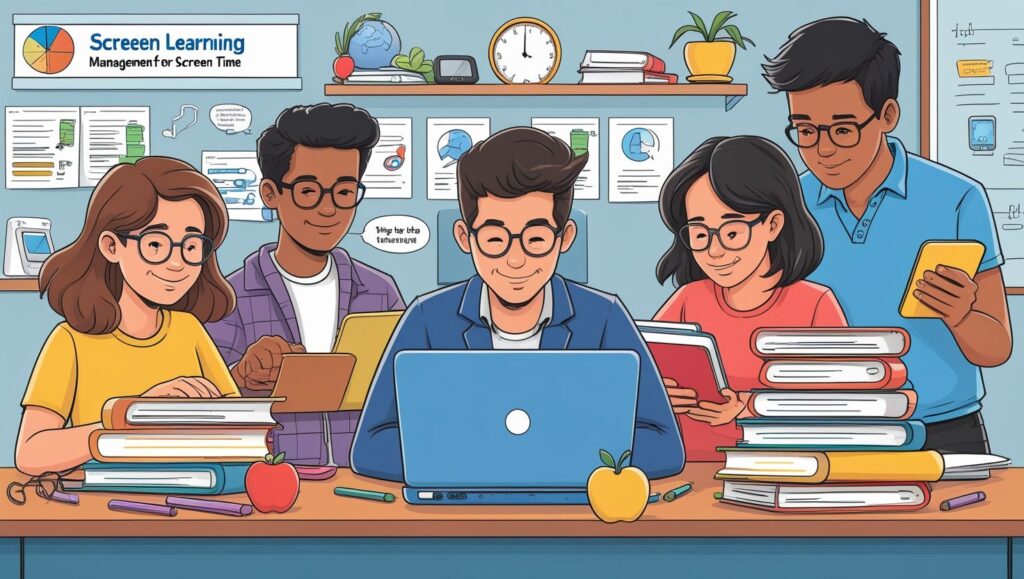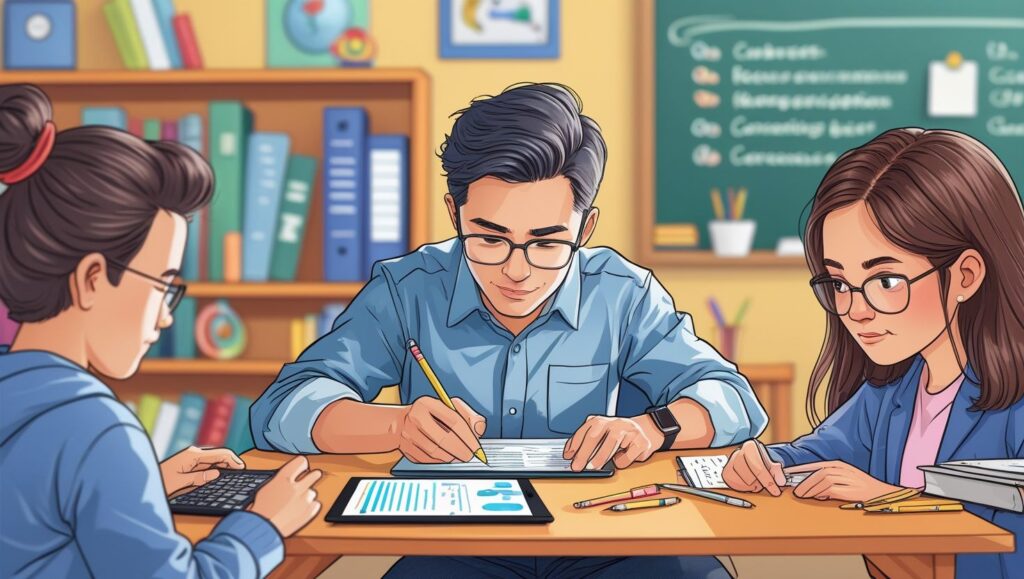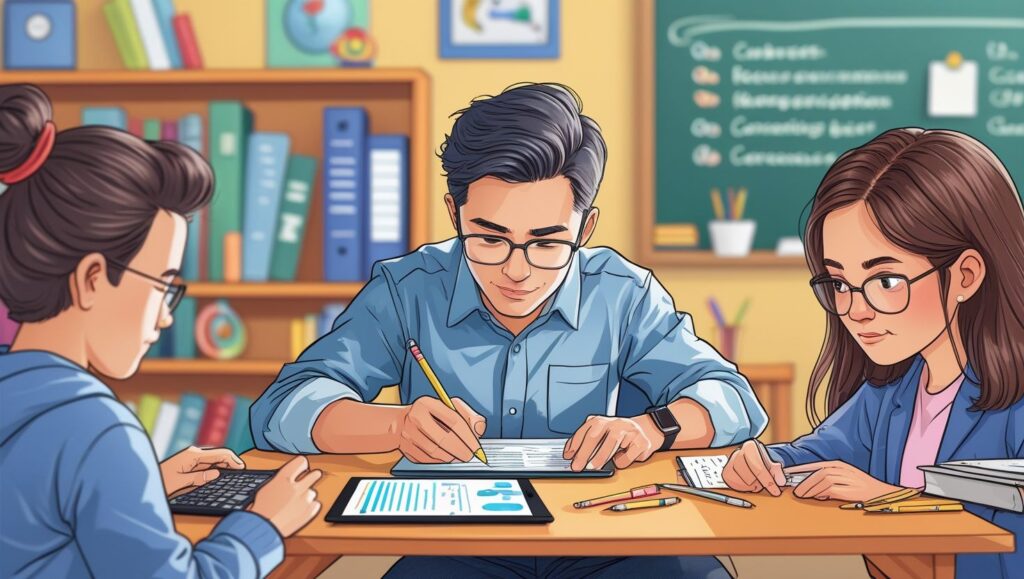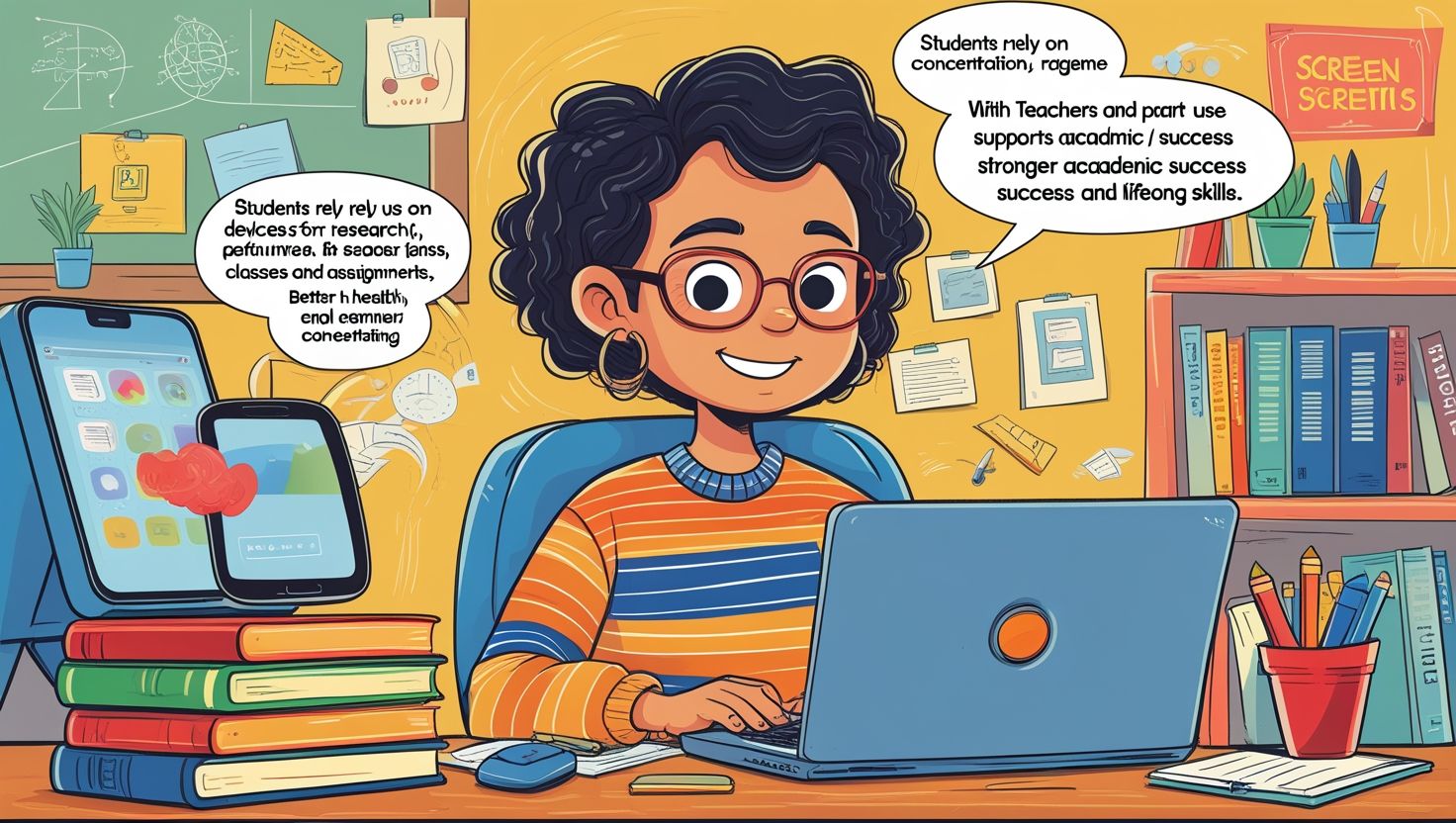Introduction
Screen Time Management for Learning, In today’s digital era, screens are everywhere. Students depend on computers, tablets, and phones to complete their studies. While technology brings many benefits, too much screen use can also create problems. Long hours on devices may affect concentration, health, and learning quality. Therefore, screen time management for learning has become a crucial topic. With the right balance, students can enjoy the advantages of digital tools while avoiding negative effects. Teachers, parents, and learners must understand how to use screen time wisely. By setting clear boundaries, creating schedules, and balancing activities, students can maximize their academic success.
Moreover, proper screen habits prepare them for responsible technology use in adulthood. This article explores strategies, benefits, and challenges of managing screen time for learning. Additionally, it highlights practical approaches for educators and parents. In short, balanced screen use helps students learn better and grow healthier.
The Role of Screen Time in Modern Learning
Screens are now central to modern education. Digital classrooms, online resources, and educational apps all rely on screen-based technology. Students watch videos, attend virtual classes, and research information online. Thus, screen time plays a direct role in learning. However, the quality of screen time matters more than the quantity. Spending hours on entertainment platforms does not support learning. In contrast, time spent on interactive lessons, reading materials, and practice quizzes can boost understanding.
Therefore, managing screen time requires distinguishing between educational and non-educational use. Moreover, digital devices allow access to global resources that were once impossible. Students can learn from experts worldwide, enhancing knowledge and skills. Still, uncontrolled screen use may lead to distractions, stress, and reduced focus. By setting clear learning goals, students can ensure screens remain tools for growth rather than barriers. Ultimately, screens should support learning, not replace traditional study habits.
Negative Effects of Excessive Screen Use
Excessive screen time often brings negative consequences for students. Long hours on devices can cause eye strain, headaches, and poor posture. Moreover, sitting too long reduces physical activity, increasing health risks. Besides physical issues, too much screen use also affects mental well-being. Constant exposure to screens may reduce sleep quality, leading to tiredness during study hours. Additionally, distractions from games, social media, and entertainment apps lower productivity. As a result, students may struggle to focus on their lessons.
Furthermore, heavy reliance on screens reduces face-to-face communication and social interaction. This can limit emotional growth and teamwork skills. Another concern is digital addiction, where students feel they cannot stay away from devices. Therefore, managing screen time is essential to prevent these problems. By creating balanced schedules, students can avoid negative effects while still benefiting from digital learning tools. Balance ensures health and academic progress.

Benefits of Managed Screen Time for Learning
Properly managed screen time offers many benefits for students. With balance, screens become powerful tools for effective learning. Digital platforms provide instant access to information, interactive lessons, and engaging activities. Moreover, scheduled screen use helps students stay disciplined and organized. They can focus on assignments without wasting hours online. Additionally, managed screen time reduces health risks such as eye strain and fatigue. It also allows space for physical activities, promoting overall well-being.
Another advantage is improved focus. When distractions are limited, students use devices more productively. Furthermore, parents and teachers can monitor progress more effectively with structured screen use. Balanced screen habits also prepare students for future careers, where technology skills are essential. By combining digital learning with traditional methods, students achieve better outcomes. In short, managed screen time provides both academic and personal benefits, making it vital in modern education.
Strategies for Students to Manage Screen Time
Students can manage screen time through simple strategies. First, they should create daily schedules that divide study, rest, and playtime. This ensures balance and avoids digital overuse. Second, they can set timers to limit continuous device use. Short breaks after every 30–40 minutes reduce eye strain and improve focus. Moreover, students should prioritize educational apps and avoid unnecessary scrolling on entertainment platforms. Another useful strategy is setting goals before using screens.
With clear targets, they avoid wasting time on irrelevant content. Additionally, turning off notifications during study hours prevents distractions. Students can also combine digital study with traditional methods like writing notes by hand. This not only reduces screen use but also strengthens memory. Furthermore, engaging in hobbies, outdoor games, and physical activities supports healthy balance. In short, by following these strategies, students can manage screen time effectively and achieve better learning outcomes.
Role of Parents in Screen Time Management
Parents play an important role in guiding children’s screen habits. They can set household rules that limit unnecessary screen use. For example, parents may allow devices only during specific study hours. Additionally, they should encourage breaks and outdoor activities to balance digital exposure. Monitoring the type of content children consume is equally essential. Parents can guide them toward educational platforms and block harmful distractions. Furthermore, creating a technology-free zone at home, such as dining areas, promotes family bonding. Parents must also serve as role models.
When adults demonstrate healthy screen use, children are more likely to follow. Moreover, discussing the benefits and risks of screen time openly helps children understand the importance of balance. By actively engaging with their children’s learning activities, parents can build trust and discipline. Ultimately, parental involvement ensures that screens remain tools for education rather than sources of distraction or harm.

Teacher’s Role in Promoting Healthy Screen Habits
Teachers are equally responsible for promoting healthy screen time management. In classrooms, they can design lessons that balance digital and traditional learning. For instance, a teacher may use interactive apps for explanations but assign handwritten tasks for practice. This prevents students from becoming overly dependent on screens. Furthermore, teachers can educate students about the risks of excessive screen use. By raising awareness, they encourage responsible behavior. Teachers may also introduce time management skills as part of lessons. Students learn how to organize digital study hours effectively. Additionally, teachers can recommend quality educational websites and applications.
This guides students toward useful content while avoiding distractions. Collaborative activities like group discussions and hands-on projects also reduce screen reliance. Moreover, regular feedback from teachers ensures students use their devices productively. In conclusion, teachers play a vital role in shaping balanced habits that support long-term learning success.
Balancing Online and Offline Learning
Balancing online and offline learning is essential in modern education. While digital platforms offer flexibility and resources, traditional methods still hold value. Reading physical books, writing notes, and engaging in classroom discussions build deeper understanding. Therefore, students should combine both methods for maximum benefit. For example, they can watch online tutorials but later summarize content on paper. This reinforces memory and reduces continuous screen use. Additionally, offline activities such as library visits and group study sessions improve collaboration.
Teachers and parents should encourage this balance by designing learning routines that mix digital and non-digital tasks. Moreover, outdoor learning experiences, experiments, and field trips provide real-world knowledge beyond screens. This not only reduces screen time but also builds creativity and critical thinking. In short, balancing both approaches ensures students gain knowledge without over-dependence on devices. Blended learning prepares them for diverse academic and life challenges.
Digital Tools for Screen Time Management
Several digital tools can help manage screen time effectively. Many applications track daily usage and alert students when limits are reached. These tools allow learners to monitor habits and make improvements. Some apps even block distracting websites during study sessions. This ensures students stay focused on educational tasks. Additionally, built-in device features like “focus mode” and “screen time reports” are useful. They provide clear insights into how time is spent online.
Parents and teachers can also use parental control software to guide children’s learning activities. Moreover, productivity apps like planners and task managers encourage organized study schedules. By using these tools, students avoid overuse and improve efficiency. Importantly, technology can support discipline rather than hinder it when used correctly. Therefore, digital tools for screen time management are valuable allies. They turn devices into effective learning partners instead of constant sources of distraction.
Long-Term Impact of Healthy Screen Time Habits
Developing healthy screen time habits creates lasting benefits for students. In the short term, they experience better concentration, improved health, and higher productivity. Over time, these habits build strong self-discipline and time management skills. Such qualities are essential for success in higher education and future careers. Moreover, students who balance screen use with offline activities maintain better social and emotional growth. They build teamwork, communication, and leadership skills.
Healthy habits also reduce risks of digital addiction, sleep problems, and poor posture. As technology continues to grow in daily life, responsible screen use becomes even more critical. Students who practice balance today will manage future challenges more effectively. Additionally, these habits encourage lifelong learning, as individuals use technology without becoming dependent on it. Ultimately, long-term impact shows that managing screen time is not just about academics. It shapes healthier, more capable, and more confident individuals.

Conclusion
Screen time management for learning is essential in the digital age. While screens bring valuable resources, they must be used responsibly. Excessive use causes health problems, distractions, and reduced learning quality. However, managed screen time leads to focus, discipline, and improved performance. Students, parents, and teachers all share responsibility in creating balance. With effective strategies, such as schedules, breaks, and monitoring tools, students gain benefits while avoiding risks.
Blending online and offline methods ensures deep learning and creativity. Moreover, healthy habits established during school years have long-term positive effects on health and success. In conclusion, screen time management is not about avoiding technology but about using it wisely. By practicing discipline, students can transform screens into powerful learning allies. Therefore, balanced screen use is the key to achieving academic excellence and building lifelong skills in today’s digital world.
References
- American Academy of Pediatrics. (2016). Media and Young Minds. Pediatrics, 138(5).
- Cain, N., & Gradisar, M. (2010). Electronic media use and sleep in school-aged children. Sleep Medicine, 11(8), 735–742.
- Twenge, J. M., & Campbell, W. K. (2018). Associations between screen time and lower psychological well-being. Preventive Medicine Reports, 12, 271–283.
- Rideout, V. (2015). The Common Sense Census: Media use by tweens and teens. Common Sense Media.
- Ophir, E., Nass, C., & Wagner, A. D. (2009). Cognitive control in media multitaskers. PNAS, 106(37), 15583–15587.

z9m9rb